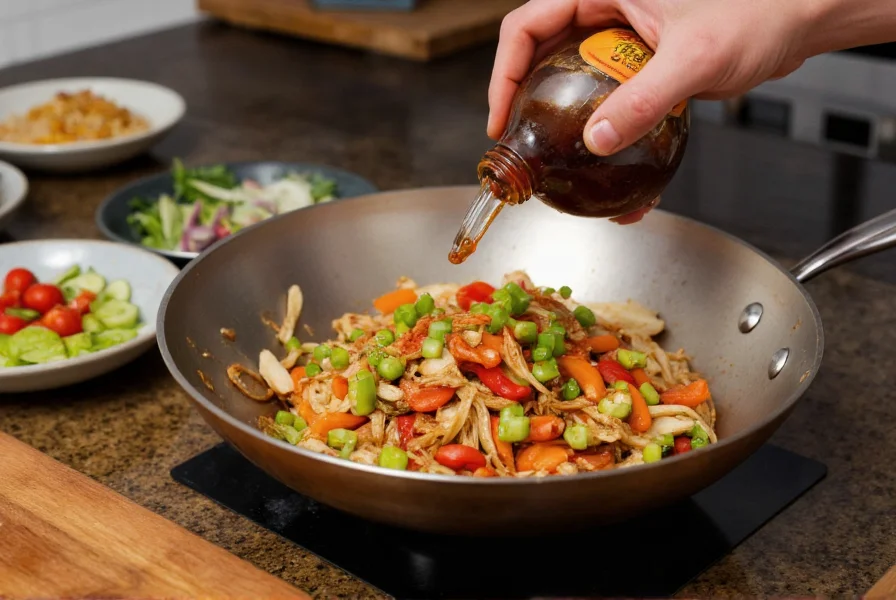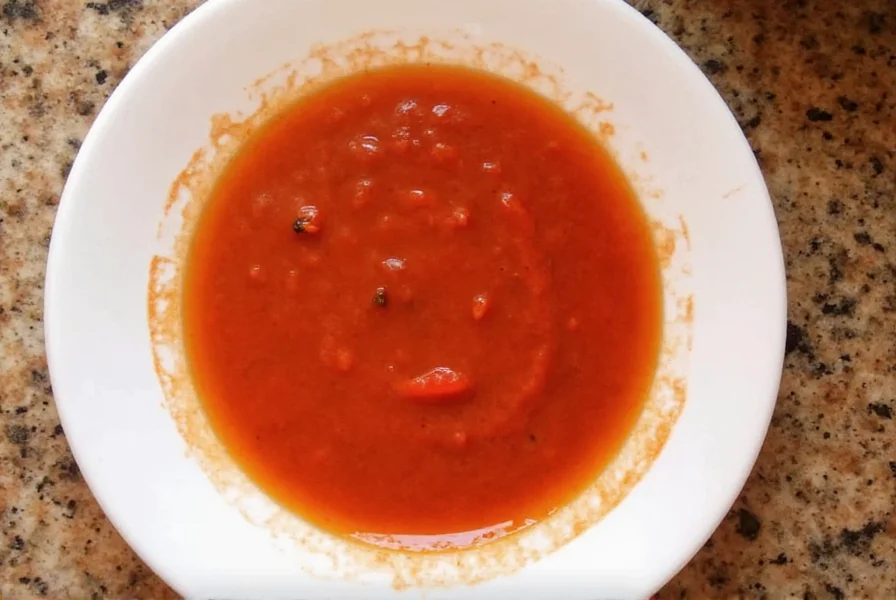If you're reaching for chili sauce only to find your bottle empty, don't panic. Many common pantry staples can effectively replace chili sauce in recipes while maintaining the essential heat, tang, and depth this versatile condiment provides. Whether you're making stir-fries, marinades, dipping sauces, or glazes, understanding the right substitute for chili sauce can save your meal without requiring a grocery run.
Understanding Chili Sauce and Its Role in Cooking
Before exploring alternatives, it's helpful to understand what makes chili sauce unique. Traditional chili sauce (like the popular Thai or Chinese varieties) typically contains:
- Ground or pureed chilies for heat
- Vinegar for tanginess
- Sugar for balance
- Garlic and spices for complexity
- Sometimes tomato or other bases
When seeking a chili sauce replacement for stir fry or other dishes, consider which elements are most important for your specific recipe. Some dishes need the heat primarily, while others rely on the sweet-tangy balance.
Top 10 Practical Chili Sauce Substitutes

1. Sriracha and Ketchup Blend
This easy chili sauce replacement ingredients combination works remarkably well. Mix 2 parts ketchup with 1 part sriracha. The ketchup provides sweetness and body while sriracha delivers the chili heat. Perfect for:
- Asian-inspired marinades
- Dipping sauces
- Glazes for proteins
Ratio: Use 1:1 as direct substitute for mild chili sauce, or adjust sriracha for more heat.
2. Sambal Oelek
Pure ground chili pepper paste with vinegar and salt, sambal oelek is the closest match for heat without additional flavors. It lacks the sweetness of many chili sauces, so you may want to add a pinch of sugar. Ideal for:
- Authentic Southeast Asian recipes
- When you need pure chili heat
- Recipes where additional sweetness would be problematic
Ratio: Use 1:1 as direct substitute for chili sauce in most applications.
3. Hot Sauce and Tomato Paste
For a homemade chili sauce alternative with depth, combine 2 tablespoons tomato paste with 1 tablespoon your favorite hot sauce (like Frank's RedHot) and 1 teaspoon vinegar. This mimics the texture and flavor profile of many commercial chili sauces. Works well in:
- Barbecue sauces
- Meatloaf mixtures
- Stir-fry sauces
4. Harissa Paste
This North African chili paste brings smoky, complex heat with garlic and spices. It's spicier than most chili sauces, so use less initially. Best for:
- Middle Eastern or Mediterranean fusion dishes
- When you want deeper, smokier flavor
Ratio: Use half the amount of harissa compared to chili sauce required.
5. Gochujang
Korean fermented chili paste offers sweet, spicy, and umami flavors. It's thicker and more complex than standard chili sauce. Excellent for:
- Korean-inspired dishes
- When you want richer, fermented flavor
Ratio: Thin with water or vinegar to match consistency, use 3:4 ratio compared to chili sauce.
6. Fresh Chili Peppers
For the freshest substitute for chili sauce in recipes, mince fresh red chilies (like Thai bird chilies or serranos) and mix with equal parts vinegar and a touch of sugar. Provides vibrant, fresh heat ideal for:
- Fresh salsas
- Raw preparations
- When you want visible chili pieces
7. Chili Flakes in Oil
Soften 1 teaspoon red pepper flakes in 2 tablespoons warm oil (like sesame or vegetable oil). Let steep for 15 minutes. Simple solution when:
- You need quick heat infusion
- Making oil-based sauces or dressings
8. Chipotle Sauce
Smoky and spicy, chipotle in adobo sauce (blended smooth) works well when you want a different flavor dimension. Great for:
- Mexican-Asian fusion dishes
- When smokiness complements your recipe
Ratio: Use 3:4 ratio compared to chili sauce, thin with water if needed.
9. Ketchup and Hot Sauce
A simpler version of our first recommendation: mix 3 parts ketchup with 1 part hot sauce. The mild substitute for chili sauce when you want familiar flavors with adjustable heat. Perfect for:
- Family-friendly dishes
- When serving to those who prefer milder heat
10. DIY Quick Chili Sauce
Make your own gluten free chili sauce replacement in minutes: blend 1/4 cup tomato sauce, 1 tablespoon vinegar, 1 teaspoon sugar, 1 minced garlic clove, and 1-2 teaspoons of your preferred chili powder or fresh chilies to taste. Customize to your exact preference for:
- Complete control over ingredients
- Dietary restrictions
- Specific flavor profiles
| Substitute | Best For | Heat Level | Special Notes |
|---|---|---|---|
| Sriracha + Ketchup | General purpose, dipping sauces | Moderate | Add rice vinegar for authenticity |
| Sambal Oelek | Authentic Asian recipes | High | Add sugar if recipe needs sweetness |
| Hot Sauce + Tomato Paste | Stir-fries, marinades | Adjustable | Closest texture match |
| Harissa | Middle Eastern fusion | Very High | Smoky, complex flavor profile |
| Gochujang | Korean-inspired dishes | Moderate-High | Fermented, sweet umami flavor |
Choosing the Right Substitute for Your Needs
The best chili sauce substitute for stir fry differs from what you'd use in a dipping sauce or marinade. Consider these factors when selecting your alternative:
- Heat tolerance: Adjust ratios based on your preference and the dish's intended audience
- Sweetness level: Some substitutes lack the sugar content of commercial chili sauces
- Texture needs: Some recipes require the specific viscosity of chili sauce
- Dietary restrictions: Many commercial chili sauces contain gluten, sugar, or preservatives
- Flavor profile: Consider whether smokiness, garlic notes, or pure heat best serves your dish
Diet-Specific Alternatives
For those with dietary concerns, these targeted chili sauce replacement for stir fry options work well:
- Gluten-free: Most substitutes listed are naturally gluten-free, but always check hot sauce labels
- Vegan: All options are vegan except those using fish sauce (check labels on commercial products)
- Low-sodium: Make your own blend using low-sodium ingredients
- Sugar-free: Skip added sugars and use vinegar-based alternatives
Common Substitution Mistakes to Avoid
Even with the right substitute, these errors can ruin your dish:
- Not adjusting for sweetness: Many substitutes lack the sugar in commercial chili sauce
- Overcompensating on heat: Start with less spicy substitute and add gradually
- Ignoring texture differences: Some substitutes are thinner or thicker than chili sauce
- Adding at the wrong time: Heat-sensitive ingredients lose flavor if added too early
Final Tips for Successful Substitution
When using any substitute for chili sauce, remember these professional kitchen tips:
- Taste as you go—substitutes vary in intensity
- Add substitute gradually, especially with spicy options
- Consider adding a touch of umami (like soy sauce) to mimic commercial chili sauce complexity
- For best results, let sauces meld for 10-15 minutes before serving
- When in doubt, sambal oelek with a pinch of sugar is the most versatile starting point

Frequently Asked Questions
Can I use hot sauce instead of chili sauce?
Yes, but hot sauce alone lacks the body and sweetness of chili sauce. For best results, mix 1 part hot sauce with 2 parts tomato paste or ketchup to create a more complete substitute that better matches chili sauce's texture and flavor profile.
What's the best mild substitute for chili sauce?
For a mild alternative, combine 3 parts ketchup with 1 part mild hot sauce (like paprika-based hot sauce). This provides the sweet-tangy profile of chili sauce with minimal heat, making it ideal for family meals or when serving guests with varying heat preferences.
How do I substitute chili garlic sauce for regular chili sauce?
Chili garlic sauce can be used as a 1:1 substitute for chili sauce, but it has a stronger garlic flavor and slightly different texture. If the garlic flavor is too pronounced for your recipe, dilute with a small amount of water or vinegar to balance the intensity while maintaining the heat level.
Can I make a gluten-free chili sauce replacement?
Absolutely. Most homemade substitutes are naturally gluten-free. Try sambal oelek (check label for purity), or make your own blend using fresh chilies, vinegar, and sugar. Avoid soy sauce unless it's specifically labeled gluten-free, as traditional soy sauce contains wheat.
What's the difference between sambal oelek and chili sauce?
Sambal oelek is pure ground chilies with vinegar and salt, while chili sauce typically includes additional ingredients like garlic, sugar, and sometimes tomato. Sambal provides straightforward heat, whereas chili sauce offers a more complex sweet-spicy-tangy profile. Use sambal oelek as a base and add sugar/vinegar to mimic chili sauce.











 浙公网安备
33010002000092号
浙公网安备
33010002000092号 浙B2-20120091-4
浙B2-20120091-4